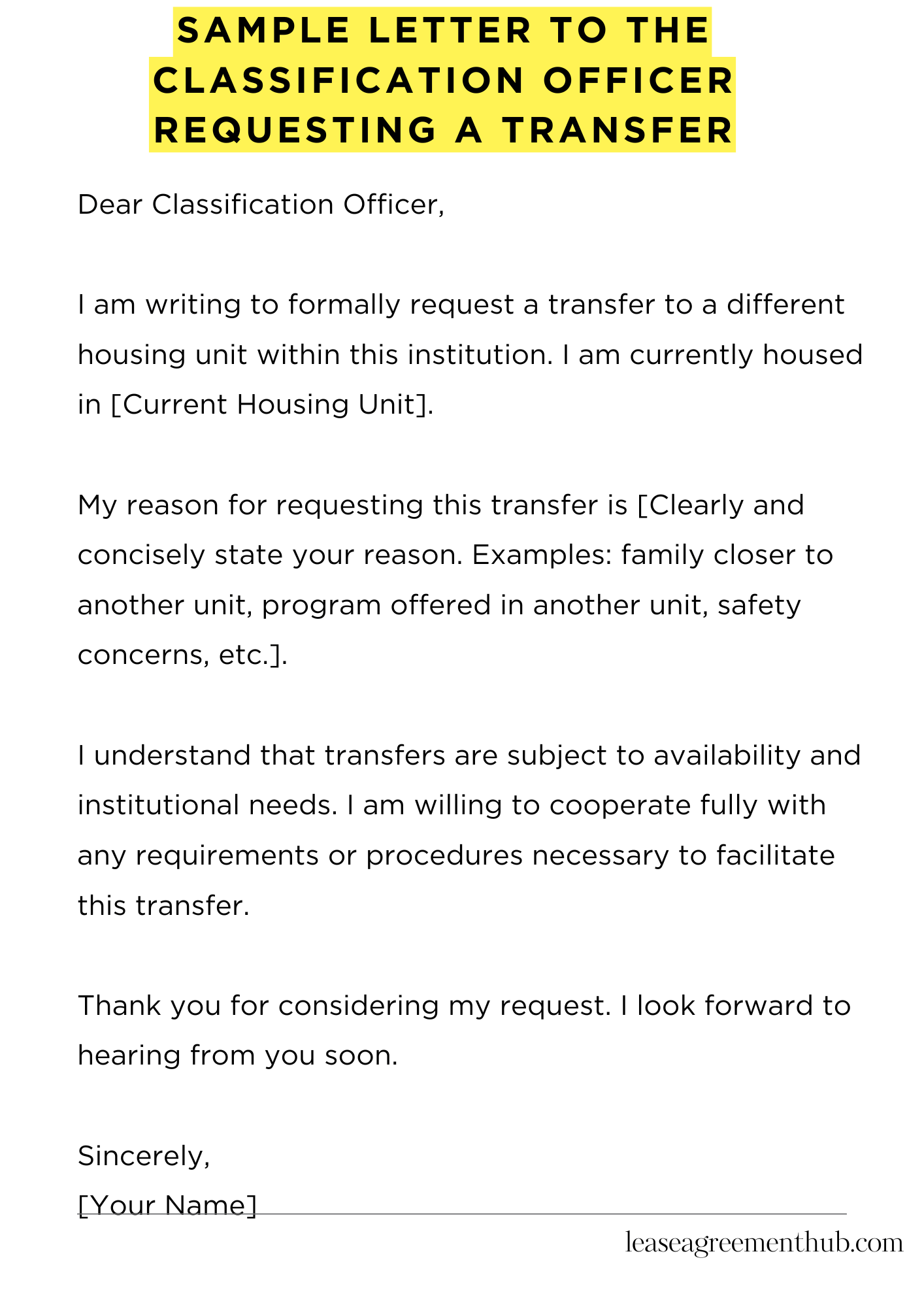A “Sample Letter To The Classification Officer Requesting A Transfer” is a formal request. You write it to ask for a job change within a correctional facility. You might need this if you’re seeking a different role or location for safety, career growth, or personal reasons.
Writing this letter can be daunting. You want to get it right. That’s why we’re here to help.
We’ll share sample letters you can use. These examples will make writing your own letter easier. Get ready to craft a clear, effective transfer request.
Sample Letter To The Classification Officer Requesting A Transfer
[Your Name]
[Your Address]
[Your City, State, Zip Code]
[Your Email Address]
[Your Phone Number]
[Date]
Classification Officer
[Institution Name]
[Institution Address]
[Institution City, State, Zip Code]
Subject: Request for Transfer
Dear Classification Officer,
I am writing to formally request a transfer to a different housing unit within this institution. I am currently housed in [Current Housing Unit].
My reason for requesting this transfer is [Clearly and concisely state your reason. Examples: family closer to another unit, program offered in another unit, safety concerns, etc.].
I understand that transfers are subject to availability and institutional needs. I am willing to cooperate fully with any requirements or procedures necessary to facilitate this transfer.
Thank you for considering my request. I look forward to hearing from you soon.
Sincerely,
[Your Name]

How to Write Letter To The Classification Officer Requesting A Transfer
1. Subject Line: Clarity is Paramount
The subject line is your letter’s headline. It needs to be succinct, clear, and compelling. Avoid vagueness; instead, opt for directness.
- Example: Transfer Request – [Your Name] – [Current Location]
- Instead of: Transfer Request
2. Salutation: Respect and Formality
Even in a seemingly informal environment, maintaining a level of decorum is crucial. Address the classification officer with respect, demonstrating your professionalism.
- Use: “Dear Classification Officer [Officer’s Last Name],”
- Avoid: “Hey,” or using their first name unless explicitly instructed otherwise.
3. Introduction: State Your Purpose Directly
Don’t beat around the bush. Immediately articulate the reason for your correspondence. Concisely state your intent to request a transfer and allude briefly to the reasons why.
- “I am writing to formally request a transfer from my current assignment at [Current Location].”
- “This request stems from [briefly mention primary reason, e.g., professional development opportunities, personal circumstances].”
4. Body Paragraphs: Elucidate Your Rationale
This section is the crux of your argument. Provide detailed, coherent reasoning for your transfer request. Subdivide your reasons into distinct paragraphs for enhanced readability.
- Professional Growth: Detail how the transfer aligns with your career trajectory and offers opportunities for skill augmentation.
- Personal Circumstances: If applicable, delicately explain any personal reasons necessitating the transfer, maintaining a balance between transparency and privacy.
- Suitability for the New Role: Emphasize your qualifications and experiences that render you an ideal candidate for the desired position or location.
5. Addressing Potential Concerns: Preemptive Reassurance
Anticipate and proactively address any potential reservations the classification officer might harbor. Demonstrate your commitment to a seamless transition.
- Acknowledge the impact of your departure and propose strategies for mitigating any disruptions.
- Offer your assistance in training your replacement or completing ongoing projects before your transfer.
6. Closing: Gratitude and Contact Information
Express your sincere appreciation for their time and consideration. Reiterate your commitment to a smooth transition and provide necessary contact information.
- Example: “Thank you for considering my request. I am available to discuss this matter further at your convenience. You can reach me at [Your Phone Number] or [Your Email Address].”
7. Formal Sign-off: Maintaining Professionalism
Conclude your letter with a formal closing that reflects respect and professionalism. Choose a sign-off that is appropriate for the context.
- Options: “Sincerely,” “Respectfully,” or “Cordially,”
- Followed by your typed name and handwritten signature (if submitting a physical copy).
Frequently Asked Questions: Transfer Request Letter
This section addresses common inquiries regarding the process of writing a transfer request letter to a Classification Officer. Understanding these points can help ensure your request is clear, concise, and effectively presented.
What information should I include in my transfer request letter?
Your letter should include your full name, employee ID, current position, desired position or department, reasons for the transfer request, relevant skills and experience, and availability for a meeting.
How formal should the tone of my letter be?
Maintain a formal and professional tone throughout the letter. Use respectful language and avoid slang or overly casual expressions.
Who should I address the letter to?
Address the letter to the appropriate Classification Officer or the individual responsible for transfer requests within your organization. Ensure you have the correct name and title.
What if I don’t know the specific position I want to transfer to?
If you are unsure of a specific position, you can express interest in transferring to a particular department or area of work, highlighting your skills and how they align with that area.
Should I mention any personal reasons for requesting a transfer?
While you can briefly mention personal reasons, focus primarily on professional reasons and how the transfer would benefit both you and the organization. Avoid overly personal or emotional details.
Related: